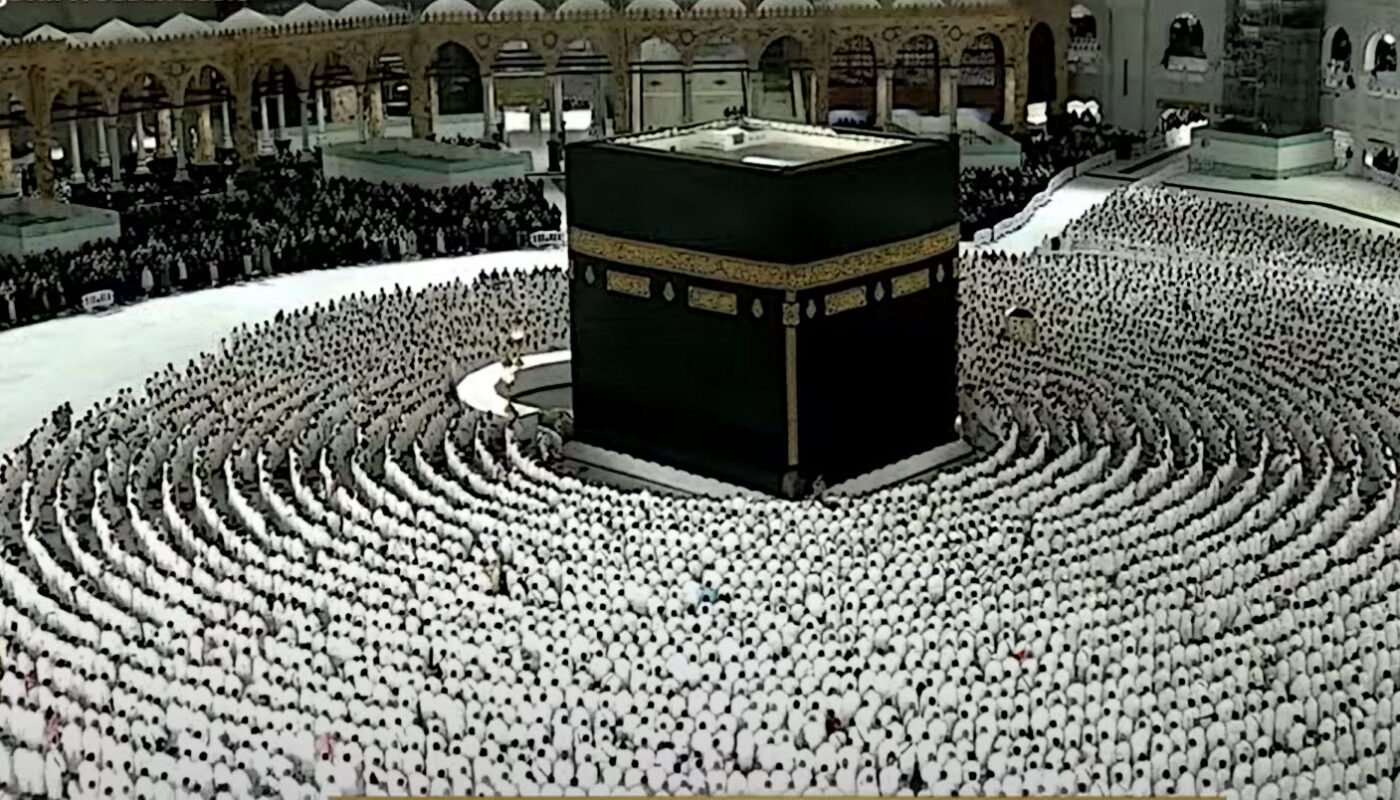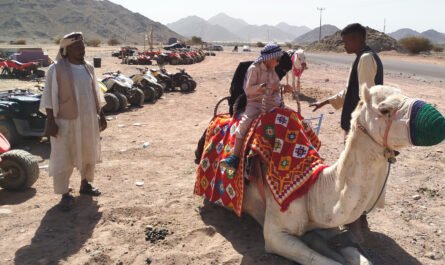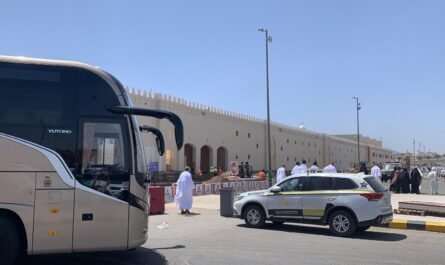Our Umrah journey really began the moment we put on our Ihram and made the dua.
After that, we said the Talbiyah—the pilgrim’s call to Allah. Honestly, there’s something about those words… you feel like you’re officially responding to His invitation.
We were actually mid-air when we entered into Ihram—somewhere between Istanbul and Jeddah. It felt surreal. The captain had announced the Miqat boundary, and that was our signal. So we made the intention for Umrah right there in the plane.
(Side note: Jeddah is one of the Miqat points—the places where pilgrims must be in Ihram before crossing into the holy zone. I’ll dive deeper into all the Miqat details and Ihram do’s and don’ts in another post, InshaAllah.)
Fast forward: we landed in Jeddah, made our way to Makkah, checked into our hotel, and without wasting a moment, headed straight for Masjid al-Haram.
When we stood there outside the famous Clock Tower, it all hit us. The Clock Tower was behind us, and facing forward, we were standing right at Bab King Abdul Aziz—Gate No.1 of Masjid al-Haram. If you’re planning your first trip, I can’t recommend enough: aim for this gate. It’s one of the main entrances, usually open, and it spares you the whole stressful experience of searching for an open door while your heart is racing with excitement (and nerves).

As you approach, you’ll notice the beautiful tall arches and intricate designs—signs that you’re about to step into one of the holiest places on Earth.
When you reach the door, don’t forget: step in with your right foot first and say the dua for entering a mosque.
Now, a little heads-up: if you arrive at a crowded time, like during the busy hours between Maghrib and Al-Isha, you might find barricades at the entrances. Please, don’t try to squeeze your way through or argue. There’s plenty of peaceful space outside the Haram and even on the first floor. Just sit, make zikr, and soak in the atmosphere. Honestly, respecting the system is one of the best ways you can show gratitude to the staff working tirelessly day and night for us.
Speaking of rules, here’s another important thing to remember: men must wear the two-piece Ihram to enter the Mataf (the open area around the Ka’bah). No fancy thobes or travel outfits—not even for little boys. If you’re not properly dressed, you’ll be sent upstairs to the first floor for Tawaf. Women, on the other hand, are fine with their regular, simple abayas.
So there we were, finally stepping through Bab King Abdul Aziz… and there it was—the Ka’bah.
SubhanAllah. No words, really. The first sight wasn’t something dramatic or overwhelming. It was deeper—a stillness that froze time for a moment. A quiet, grateful realization that this is the place we’ve been praying toward our entire lives.
Even though there were thousands of people around us, it didn’t feel like chaos. It felt rhythmic, almost like the heartbeats of all those pilgrims had synchronized. And we just knew—we had to join the flow of Tawaf.
A quick reminder: Umrah consists of three things, done in this order:
1. Tawaf around the Ka’bah,
2. Sa’i between Safa and Marwah,
3. And then Halq or Taqsir (shaving or trimming your hair).
As we walked closer, we stepped into the Mataf, the open white marble courtyard that surrounds the Ka’bah. The Ka’bah itself is that large cube covered in the iconic black cloth with golden calligraphy—the Kiswa.
(And just a little beautiful detail here: Allah commanded Prophet Muhammad ﷺ to turn his face from Masjid al-Aqsa towards the Ka’bah. It’s mentioned in the Quran, in Surah Al-Baqarah [2:149].
The Ka’bah is also the very structure built by Prophet Ibrahim (AS) and his son Ismail (AS) on the command of Allah.)
If you can’t manage to be in the Mataf on the ground floor, then do Tawaf from the first floor, still facing the Ka’bah.
One thing to note if you need a wheelchair: wheelchairs aren’t allowed in the Mataf itself. You’ll have to do Tawaf from the first floor. There are people available who can push your wheelchair for you, for a fee. When we went, it was about 100 riyals for Tawaf and Sa’i combined. But just a heads-up, if you’re visiting during busy seasons like Ramadan, that price could double or even triple.
So wherever you are—Mataf or first floor—you can still complete your Tawaf, InshaAllah.
Alright, so let’s talk about Tawaf — one of those core parts of Umrah that you absolutely can’t skip. It’s basically circling the Ka’bah seven times counterclockwise. Simple, right? But there’s a bit more to it when you’re actually there.

Just like Salah, Tawaf needs you to be in a state of purity. That means Wudu is a must. And one more tip? Try not to start your Tawaf right before a Fard prayer, because everything will pause for Salah, and you’ll have to wait.
Before jumping into Tawaf, it’s a good idea to find a quiet spot and pray two rak’ahs of nafl for Umrah. Just take a moment, make your intention for Tawaf, and then get ready to step into line.
Now, to actually begin Tawaf, you’ll turn to your right and head toward the eastern corner of the Ka’bah. That’s where you’ll find the famous Hajar al-Aswad — the Black Stone — set inside a silver frame. It’s dark, shiny, and holds such a beautiful place in our history. The Prophet Muhammad (peace be upon him) himself placed this stone back in its spot during the rebuilding of the Ka’bah — a moment of unity for the people of Makkah.
If you’re wondering where exactly to start your Tawaf from, look for the green light up on the wall facing the courtyard. If you’re on the first floor, the green light will be on your right-hand side, in line with the Hajar al-Aswad both in the courtyard and on the first floor. Stay behind this line. Then turn your body toward the Black Stone, raise your hands, and say “Allahu Akbar.”
Now, let’s be real — most of the time, it’s packed around the Hajar al-Aswad. So if you can’t actually touch or kiss it, then just point toward it with your right hand, say “Allahu Akbar,” and then kiss your hand. This symbolic gesture is called Istilam. That’s how your Tawaf officially starts.
As you begin walking, you can quietly make duas, recite Quran, or even carry a little dua book with you. I had the Islam One app installed on my phone, and honestly, it made everything so easy — all the Quranic duas I wanted were right there at my fingertips.
One small thing: while walking, we didn’t keep our eyes locked on the Ka’bah. Instead, we looked ahead, focusing on our steps and our dhikr, trying not to bump into people.
Men have a little extra Sunnah step here — it’s called Ramal. For the first three circuits, men should march briskly, not jogging or running, just walking with energy. You lift your legs with strength, push your chest out a bit, and let your shoulders move naturally. Women, though, should just walk normally — no Ramal for us.
A few steps after you start, you’ll pass something really special — the Ka’bah Door. It’s this beautiful golden door, a few meters above ground level, usually closed. It leads into the Ka’bah itself, and only on rare, special occasions is it opened. When you walk past, you can glance up and make a heartfelt dua, but keep moving with the flow of the Tawaf.
Just below the door, there’s the Multazam — the area between the Black Stone and the Ka’bah Door. This is a powerful place to pour out your prayers, asking Allah for everything your heart desires.
Keep walking, and you’ll come to the next corner. Just past it, on the northwest side of the Ka’bah, and you’ll spot the Hatim.

It’s a small, semi-circular wall made of white marble, really close to the Ka’bah. The Hatim actually marks part of the original Ka’bah foundation, so during Tawaf, you need to go around it, not through it. But later, if you want to pray inside the Hatim, it’s a very special place to make dua.
Above the Hatim, if you look up, you’ll see the Mizab — a little golden waterspout coming out of the Ka’bah’s roof. It’s used to drain rainwater.
As you continue, you’ll reach another corner, the Northwest Corner or the Al-Rukn Al-Shami, followed by the next important corner — the Rukn al-Yamani, or the Yemeni Corner. It’s the one just before you come back to the Black Stone. There’s no green light or special marker, but you’ll recognize it easily because of its location.
Between the Rukn al-Yamani and the Black Stone, pilgrims often recite this beautiful dua:
When you reach the line between the Hajar al-Aswad and the green light again, that’s the end of your first round. You’ll stop briefly, turn towards the Black Stone again, point with your hand, say “Allahu Akbar,” kiss your palm, and off you go for round two.
You keep going like this, seven full circles — each one starting and ending at the Hajar al-Aswad. Each step, each round, is a moment to connect your heart deeper to Allah.
Once you finish your Tawaf — completing that seventh circle at the invisible line between the Hajar al-Aswad and the green light — don’t rush away just yet. Walk a little further, still moving as if you’re continuing Tawaf, until you come across something beautiful: the Maqam Ibrahim.
It’s a small, glass-enclosed structure, not too far from the Ka’bah. Inside, you’ll see a stone — and on it, the faint imprint of Prophet Ibrahim’s (peace be upon him) blessed feet. This is the very spot where he stood while building the Ka’bah, raising its walls with devotion, faith, and trust in Allah.
After completing your Umrah — or even during it, when you find the right moment — it’s Sunnah to pray two rak’ahs near the Maqam Ibrahim, facing the Ka’bah.
For us, the opportunity came unexpectedly. It was right around Maghrib. As the adhan echoed across the Haram and people began forming their rows for Salah, we found ourselves near the Maqam. Allah opened the way for us, and we managed to pray our two rak’ahs right there — a small gift wrapped inside a much bigger one.
Just a note: during the Salah, women need to move toward the back of the Mataf area, or even into the courtyard itself, to give space for the prayer lines. It flows naturally; just follow the volunteers’ directions with patience and grace.
And if you ever have to pause your Tawaf — maybe for Salah, or because you’re too tired, or need a restroom break — don’t worry. You don’t need to start your Tawaf over. You simply pick up right where you left off. The same rule applies later during Mas’a, which I’ll discuss in the next post.
If you would like to stay connected and journey with us as we share more reflections and guidance on Umrah, you are warmly invited to follow our path.
Join us on Instagram: @familycompass016 or become part of our WhatsApp community here.



